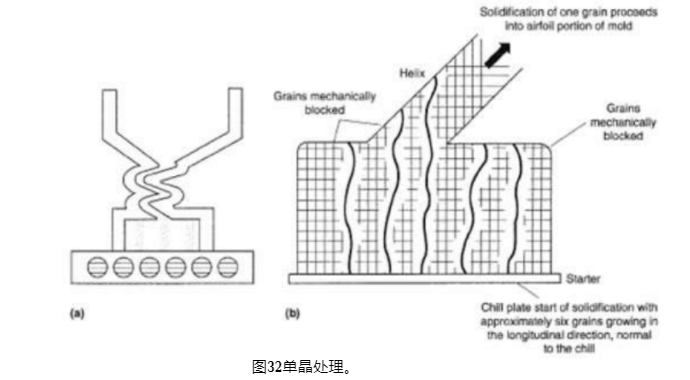Gas turbine blades have to resist severe conditions such as elevated temperatures, high centrifugal forces and oxidation. Nowadays directional solidification (DS) and single crystal (SX) methods are used to cast the blades because conventional casting methods create superalloys with unsatisfying high-temperature properties caused by the equiaxed grain structure. Conventionally casted superalloys failed at the grain boundaries because of thermal fatigue, oxidation and creep. Grain boundaries are places for failure initiation. The alignment or elimination of these improves creep strength and ductility at high temperatures. To cast turbine blades is very complicated. Simplified, a mould is made by pouring a ceramic around a wax model of the blade.
Then the wax model is removed and the mould is filled with the molten metal. Directional solidification (DS) The directional
solidification of superalloys was introduced in the sixties.The grain boundaries are aligned parallel to the solidification direction which coincides with the principal stress axis of the component. A final structure is produced which consist of columnar grains with <001> orientation in the direction of the afterwards applied load. DS turbine blades with the low modulus <001> orientation parallel to the direction of the applied load increase the thermal fatigue resistance drastically compared to conventionally cast turbine blades.
Single crystal (SX) casting
The process is shown in Figure 32. Single crystal casting is executed in vacuum in a preheated, ceramic mould.
Figure 32 Single crystal processing.

Because of the controlling of the solidification in the mould, the growth of all grains can be inhibited and therefore grain boundaries are eliminated. The mould is solidified from the bottom. At the beginning of the solidification the grains have a columnar structure which is perpendicular to the thermal gradient. When the helical channel is reached all columnar grains except one are prevented from growing. At the end of the helix a single crystal is produced. Single crystal superalloys possess better high-temperature properties than DS superalloys because of the fault of grain boundary strengthening solutes such as boron and zirconium. The missing of these elements increases the incipient melting temperature of the superalloy and thus the high-temperature properties are improved.
Moreover the alloys can be heat treated at higher temperatures in the range of 1240–1330° C. This higher heat
treatment temperature allows a dissolving of all g´ and finer precipitates after the aging treatment.

